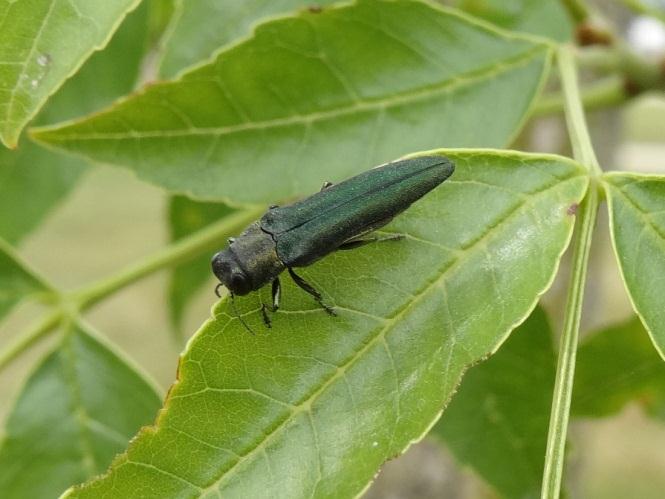Insects, either individually or as a large group, can kill your trees, so it is a good idea to keep an eye out for them and monitor the health of your trees.
I was assessing the health of our trees recently, and noticed some that looked a bit under the weather. Many of the branches had produced only a few leaves, while others produced none at all. These same trees were completely healthy and seemed to be doing just fine when I checked them the previous year.
Upon further inspection, I discovered what I think is the culprit in the demise of these trees. Under the bark, there were larvae (newly hatched insects) chewing away on the wood. This was a bad sign for these trees, and was bad news for the surrounding trees if we didn’t take any action to protect them.
We ended up harvesting all of the infested trees and did a more thorough inspection of the surrounding trees to see how far the infestation had spread. Fortunately, the insects had only attacked a few of our trees, but it got me thinking about the power those tiny creatures have over mighty trees.
Insects can lead to the death of trees by either killing them directly or by carrying a pathogen to the tree, which then kills the tree. Insects, through their feeding and reproductive actions, can also weaken a tree’s defenses such that other critters and diseases can take hold and kill it. A lethal one-two punch.
Some insects can kill a tree with just one individual or a small group. Insects associated with the transport of oak wilt and dutch elm disease are good examples of these. However, most species of insects rely on large populations over several years to eventually kill trees, more often than not through feeding on leaves/needles or bark. Those reproducing in high numbers and feeding on the leaves of trees get the most attention. Gypsy moths, forest tent caterpillars, and spruce bud worms fit into this category, and we spend a lot of time and money to kill them to reduce their impact.
Healthy broadleaved trees like oak and maple can survive a year or two of all their leaves getting eaten. These trees can sprout new leaves and do just fine. Whereas evergreens, like the pines and spruces, cannot sprout new needles and usually perish quickly. However, if the defoliation continues for more than two years in broadleaf trees, then the trees will most likely die. Even the stress caused by just a year’s worth of defoliation can lead to the death of saplings or unhealthy trees. When trees become stressed, they are less able to fend off attacks from insects and diseases, and may succumb to those.
The insects that feed on the wood beneath the bark are the most interesting to me. The adults of these insects will either lay their eggs on top of or underneath the bark. When the larvae hatch, they feed on the surrounding tissue.
It wouldn’t seem like the feeding of these little buggers could have much impact, but in fact it is just the opposite. That wood and bark they are feeding on is critical for the transport of water up from the roots and sugars down from the leaves. The tunnels the larvae create with their feeding effectively cuts off that flow, and can choke the life out of a tree. The two-lined chestnut borer (which feeds on oak) and the emerald ash borer are good examples of insects that feed in this manner.
Then there are those insects that act as the 18 wheeler for diseases, hauling them from tree to tree. These insects are attracted to the sap produced when trees are injured. They fly from wounded tree to wounded tree feeding on this sap and carrying along with them the diseases that can kill a tree. It is one of the ways that oak wilt gets from an infected tree to healthy trees. This is the main reason why it is a bad idea to prune oaks in the spring and summer, since you are effectively wounding a healthy tree that could attract the beetle carrying oak wilt.
The thing to keep in mind regarding insects and diseases is that they are out there and will prey upon your trees if you give them the opportunity. That is why I am diligent about keeping an eye out for any signs that they might be affecting our trees. That might be looking for the insects or diseases (signs like mushrooms) themselves, or the impacts they are having (symptoms like dying leaves and branches).
Once you find something, it is a good idea to take some action quickly. If you are not sure what you have, contact your local DNR forester and they can help you figure out what is going. You can also take samples of insects you find or affected leaves and branches to your local Extension office for identification of the pest.
